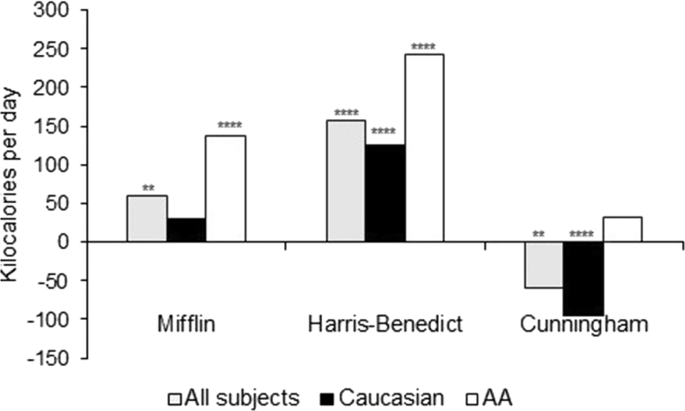当前位置:
X-MOL 学术
›
Nutr. Diabetes
›
论文详情
Our official English website, www.x-mol.net, welcomes your
feedback! (Note: you will need to create a separate account there.)
Do we need race-specific resting metabolic rate prediction equations?
Nutrition & Diabetes ( IF 4.6 ) Pub Date : 2019-07-29 , DOI: 10.1038/s41387-019-0087-8 James Reneau 1 , Brittaney Obi 1 , Andrea Moosreiner 1 , Srividya Kidambi 1
Nutrition & Diabetes ( IF 4.6 ) Pub Date : 2019-07-29 , DOI: 10.1038/s41387-019-0087-8 James Reneau 1 , Brittaney Obi 1 , Andrea Moosreiner 1 , Srividya Kidambi 1
Affiliation

|
BACKGROUND
Resting metabolic rate (RMR) is a key determinant of daily caloric needs. Respirometry, a form of indirect calorimetry (IC), is considered one of the most accurate methods to measure RMR in clinical and research settings. It is impractical to measure RMR by IC in routine clinical practice; therefore, several formulas are used to predict RMR. In this study, we sought to determine the accuracy of these formulas in determining RMR and assess additional factors that may determine RMR.
METHODS
We measured RMR in 114 subjects (67% female, 30% African American [AA]) using IC. Along with standard anthropometrics, dual-energy X-ray absorptiometry was used to obtain fat-free mass(FFM) and total fat mass. Measured RMR (mRMR) by respirometry was compared with predicted RMR (pRMR) generated by Mifflin-St.Joer, Cunningham, and Harris-Benedict (HB) equations. Linear regression models were used to determine factors affecting mRMR.
RESULTS
Mean age, BMI, and mRMR of subjects were 46 ± 16 years (mean ± SD), 35 ± 10 kg/m2, and 1658 ± 391 kcal/day, respectively. After adjusting for age, gender, and anthropometrics, the two largest predictors of mRMR were race (p < 0.0001) and FFM (p < 0.0001). For every kg increase in FFM, RMR increased by 28 kcal/day (p < 0.0001). AA race was associated with 144 kcal/day (p < 0.0001) decrease in mRMR. The impact of race on mRMR was mitigated by adding in truncal FFM to the model. When using only clinically measured variables to predict mRMR, we found race, hip circumference, age, gender, and weight to be significant predictors of mRMR (p < 0.005). Mifflin-St.Joer and HB equations that use just age, gender, height, and weight overestimated kcal expenditure in AA by 138 ± 148 and 242 ± 164 (p < 0.0001), respectively.
CONCLUSION
We found that formulas utilizing height, weight, gender, and age systematically overestimate mRMR and hence predict higher calorie needs among AA. The lower mRMR in AA could be related to truncal fat-free mass representing the activity of metabolically active intraabdominal organs.
中文翻译:

我们是否需要特定种族的静息代谢率预测方程式?
背景技术静息代谢率(RMR)是每日热量需求的关键决定因素。呼吸测定法是间接量热法(IC)的一种形式,被认为是在临床和研究环境中测量RMR的最准确方法之一。在常规临床实践中用IC测量RMR是不切实际的。因此,使用几个公式来预测RMR。在这项研究中,我们试图确定这些公式在确定RMR中的准确性,并评估可能确定RMR的其他因素。方法我们使用IC测量了114名受试者(67%的女性,30%的非裔美国人[AA])的RMR。与标准的人体测量学一起,使用双能X射线吸收法获得无脂肪质量(FFM)和总脂肪质量。将通过呼吸测定法测得的RMR(mRMR)与Mifflin-St.Joer,Cunningham,和Harris-Benedict(HB)方程。线性回归模型用于确定影响mRMR的因素。结果受试者的平均年龄,BMI和mRMR分别为46±16岁(平均±SD),35±10 kg / m2和1658±391 kcal /天。在调整了年龄,性别和人体测量学后,mRMR的两个最大预测指标是种族(p <0.0001)和FFM(p <0.0001)。FFM每增加1千克,RMR就增加28 kcal /天(p <0.0001)。AA种族与mRMR下降144 kcal /天(p <0.0001)有关。种族对mRMR的影响通过在模型中添加截尾FFM得以缓解。当仅使用临床测量的变量预测mRMR时,我们发现种族,髋围,年龄,性别和体重是mRMR的重要预测因子(p <0.005)。仅使用年龄,性别,身高,和体重高估了AA的大卡支出138±148和242±164(p <0.0001)。结论我们发现利用身高,体重,性别和年龄的公式系统地高估了mRMR,因此可以预测机管局中更高的卡路里需求。AA中较低的mRMR可能与代表代谢活跃的腹腔内器官活动的无节状脂肪有关。
更新日期:2019-07-29
中文翻译:

我们是否需要特定种族的静息代谢率预测方程式?
背景技术静息代谢率(RMR)是每日热量需求的关键决定因素。呼吸测定法是间接量热法(IC)的一种形式,被认为是在临床和研究环境中测量RMR的最准确方法之一。在常规临床实践中用IC测量RMR是不切实际的。因此,使用几个公式来预测RMR。在这项研究中,我们试图确定这些公式在确定RMR中的准确性,并评估可能确定RMR的其他因素。方法我们使用IC测量了114名受试者(67%的女性,30%的非裔美国人[AA])的RMR。与标准的人体测量学一起,使用双能X射线吸收法获得无脂肪质量(FFM)和总脂肪质量。将通过呼吸测定法测得的RMR(mRMR)与Mifflin-St.Joer,Cunningham,和Harris-Benedict(HB)方程。线性回归模型用于确定影响mRMR的因素。结果受试者的平均年龄,BMI和mRMR分别为46±16岁(平均±SD),35±10 kg / m2和1658±391 kcal /天。在调整了年龄,性别和人体测量学后,mRMR的两个最大预测指标是种族(p <0.0001)和FFM(p <0.0001)。FFM每增加1千克,RMR就增加28 kcal /天(p <0.0001)。AA种族与mRMR下降144 kcal /天(p <0.0001)有关。种族对mRMR的影响通过在模型中添加截尾FFM得以缓解。当仅使用临床测量的变量预测mRMR时,我们发现种族,髋围,年龄,性别和体重是mRMR的重要预测因子(p <0.005)。仅使用年龄,性别,身高,和体重高估了AA的大卡支出138±148和242±164(p <0.0001)。结论我们发现利用身高,体重,性别和年龄的公式系统地高估了mRMR,因此可以预测机管局中更高的卡路里需求。AA中较低的mRMR可能与代表代谢活跃的腹腔内器官活动的无节状脂肪有关。











































 京公网安备 11010802027423号
京公网安备 11010802027423号